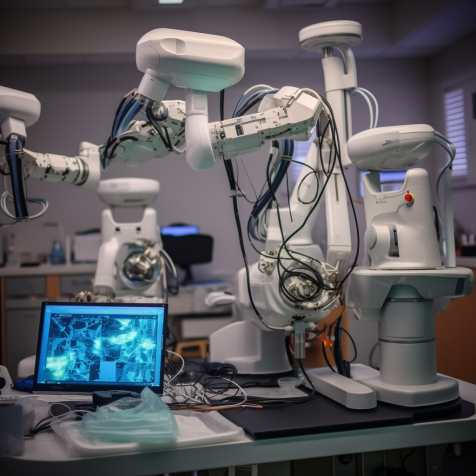Low Latency Telesurgery Is Here
Low Latency Telesurgery Is Here
Introducing IX Innovation's
Patent 11,464,589
Welcome to the future of telesurgery, where distance is no longer a barrier to providing or receiving high-quality surgical care. The patent 11,464,589 addresses the issue of adverse events during remote surgical procedures, which can be due to various factors such as communication breakdowns, delays in diagnosis or treatment, low latency, and technical errors during the operation. Its potential to enhance patient safety, increase accessibility to surgical care, and improve efficiency makes it a valuable asset for medical device startups, mid-size companies, large corporations, and investors.

Introducing IX Innovation's Patent
11,464,589
Robotic System And Method For Performing Latency Managed Telesurgery
Patent Claims
The patent is a system and method for performing low latency telesurgery. It addresses the critical issue of network latency, which can pose significant risks during remote surgical procedures. The patent outlines a system that manages drones to provide a network supporting a telesurgery procedure, ensuring a stable and reliable connection between the surgeon and the patient, regardless of their geographical locations.
WHY IS THIS PATENT
VALUABLE?
As robotic surgery evolves, this patent relates to systems and methods for performing telesurgery, specifically focusing on reducing latency
Telesurgery
The patent describes systems and methods for performing low latency telesurgery. This is particularly valuable in scenarios where the patient and the surgeon are not in the same location. The patent addresses the technical problems associated with latency in such scenarios.
Robotic Surgery
The patent introduces robotic surgery and describes systems, methods, and apparatus to perform latency managed telesurgery. This is valuable in enhancing the precision, stability, and dexterity of surgical procedures, relieving medical personnel from routine tasks, and making medical procedures safer and less costly for patients.
Machine Learning
The patent mentions the use of machine learning (ML) in the disclosed embodiments, which can be valuable in improving the performance and accuracy of the systems and methods described.
Patient Safety
The patent is valuable in improving patient safety during surgical procedures. By managing latency in telesurgery, the systems and methods described in the patent can help prevent surgical errors and adverse events during surgery.
Network Management
The patent provides a system that can manage drones to provide a network supporting a telesurgery procedure. This is valuable in geographical areas where the presence of communication infrastructure is not well established or where the network may have high latency due to congestion.
Healthcare Technology
he patent is valuable in the broader field of healthcare technology. It provides a way to manage latency in telesurgery, which can lead to more successful outcomes in remote surgeries. This can be particularly beneficial in remote parts of the world where access to high-quality healthcare facilities and professionals may be limited.
Drone Technology
The patent is valuable in the field of drone technology. It describes how drones can be used to create or be a part of a network for telesurgery, which can be particularly useful in areas where the communication infrastructure is not well established.
Why you should invest in IXI Patent
11,464,589?
Investing in Patent 11,464,589 supports the future of human surgery particularly in the artificial intelligence, machine learning, and patient data
-
By developing devices that incorporate this technology, startups can differentiate themselves in the market and offer a unique value proposition to healthcare providers.
-
Mid-size companies can leverage this patent to expand their product portfolio and enter the growing telesurgery market.
-
For large corporations, this patent can enhance their existing product line, drive innovation, and maintain their market leadership. It can also help them meet regulatory requirements and adhere to best practice guidelines for performing remote surgery.

